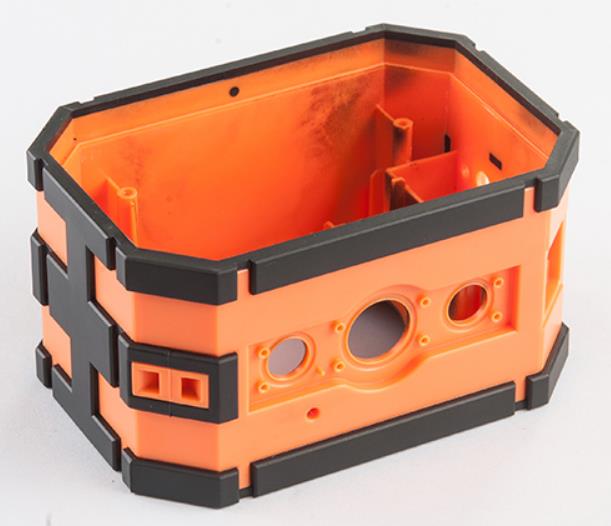
This article is a two-shot molding guide. I spent 5 days to write it. The following is a chapter layout. You can click on the link to go to the chapter you want to see.
What is Two-shot molding
Two-color injection molding is a multi-material injection molding process. The molded plastic part can be a combination of two different materials or a combination of different colors of the same material.
Two-color molding can also be called 2k injection molding, double shot molding, multiple injection molding (sequential injection molding).
Two-shot and multi-shot injection molding
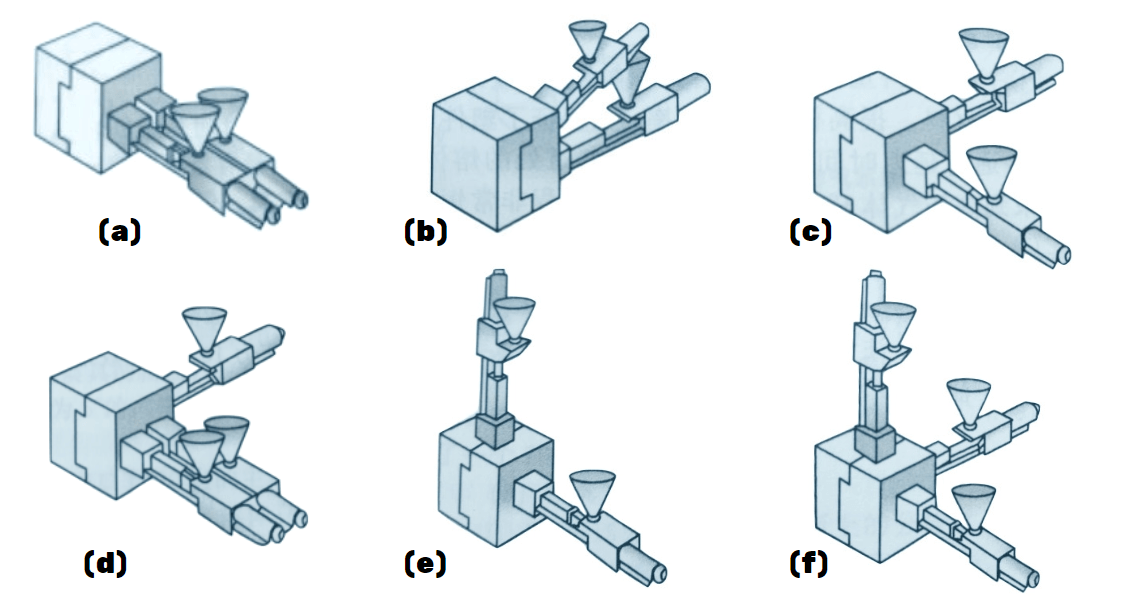
When is the use of two-shot molding?
Product function requirements.
For example, power switches, phone buttons, keyboard indicators, car switches, etc. Portion with an LED capable of transmitting light.
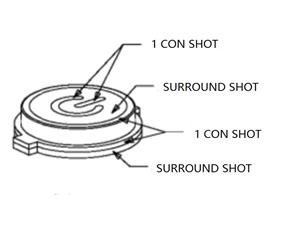
Improve the handle feeling
Some handheld products require the use of rubber in hand-held parts, which makes the hand feel more comfortable. For example, walkie-talkie housing, power tool handle, wrench, screwdriver handle, toothbrush handle, thermos, etc.
Enhance beauty
For example, some plastic parts have a logo. If you use two-color injection molding, you don’t have to worry about it being erased.
A localized area of the product that needs to be plated
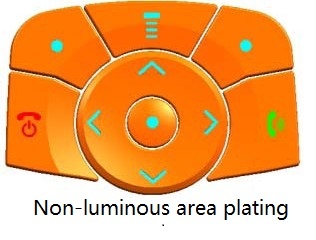
7 suggestions for product design
Two-shot molding frees the designer’s creativity. However, the following factors should also be noted in the product design process.
No.1
Choose the right material. The figure below shows the compatibility of different plastics.
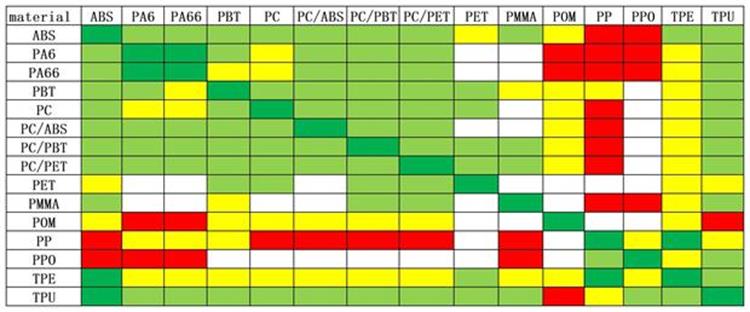

1 ) The core material can use low viscosity materials to reduce the injection pressure.
2) Consider from the perspective of environmental protection. The recycled material can be used as a core material.
3) Optimize the product according to the characteristics of different materials. For thick parts, the finished skin layer uses soft materials. The core material uses hard or foamed plastic to reduce weight.
No.2
If the material is not chemically compatible, the two materials can be integrated by mechanical interlocking.
No.3
Maintain proper draft angle, uniform wall thickness and smooth transition lines.
No.4
The surface of the part should be flush or slightly lower than any adjacent substrate surface.
No.5
The surface of the substrate is textured to improve the adhesion of the two materials.
No.6
The mass ratio of the two materials should not be too large. Factors such as material forming time and injection pressure should be considered.
No.7
By increasing the contact area of the two parts, the weld strength of the two materials can be enhanced.
5 kinds of two shot mold structure
Choosing the right mold structure is advantageous for two-shot injection molding. The right mold structure saves costs and increases efficiency. Below are five typical two-shot molds.
1. Rotary Platen Two-Shot Mold
There are two ways to rotate the platen double shot mold.
A. Two male female mold with two mold base;
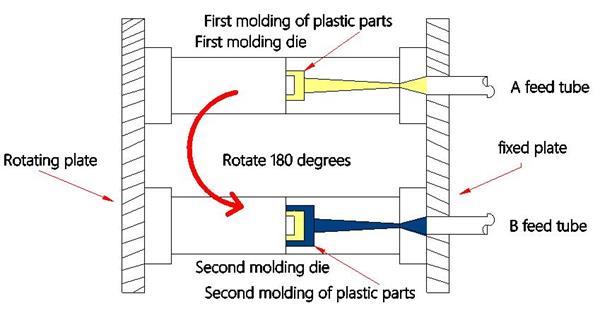
B. The two groups of male and female molds use only one mold blank;
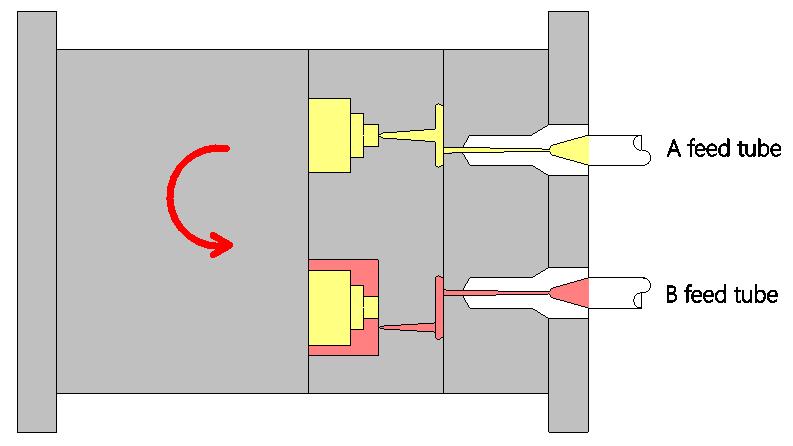
Two shot Molding cycle

2. Core Toggle Two-Shot Mold
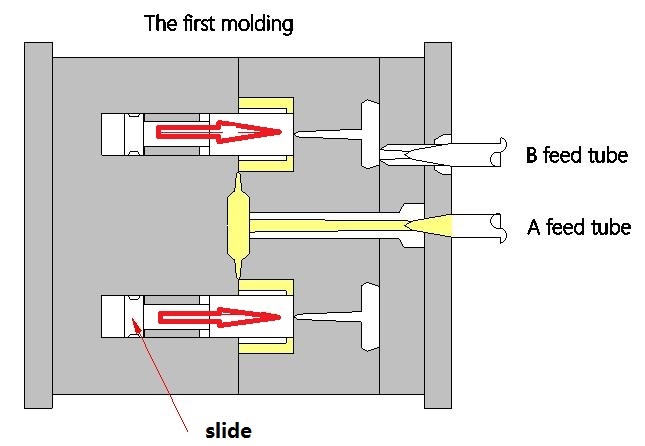
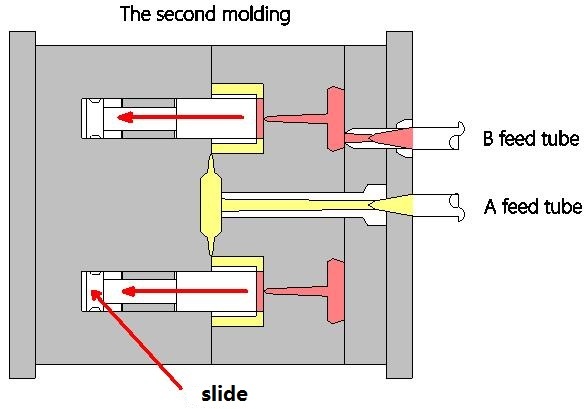
45 degree nozzle is mainly used for Core Toggle Two-Shot Mold
Two shot molding cycle
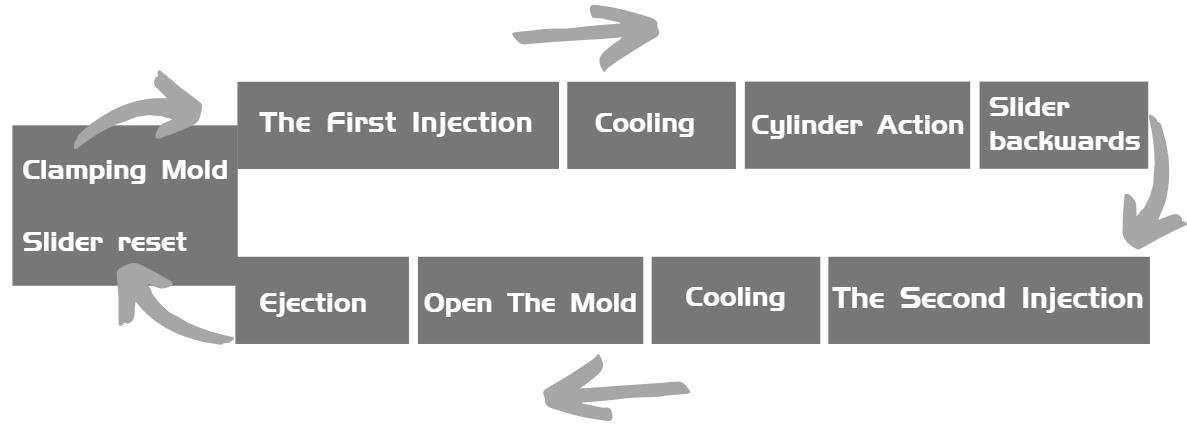
3. Seesaw two-shot mold structure
The working principle of the seesaw structure is: after another injection, the mold opens. The push rod descends, causing the jaw to rotate about the axis of rotation. The seesaw pushes the collision plate up. In this way, the impact pin moves up, creating a hole in the enclosed area of the product. When the second clamping is performed, the needle is pressed back. This way the secondary material can enter the enclosed area from the hole.
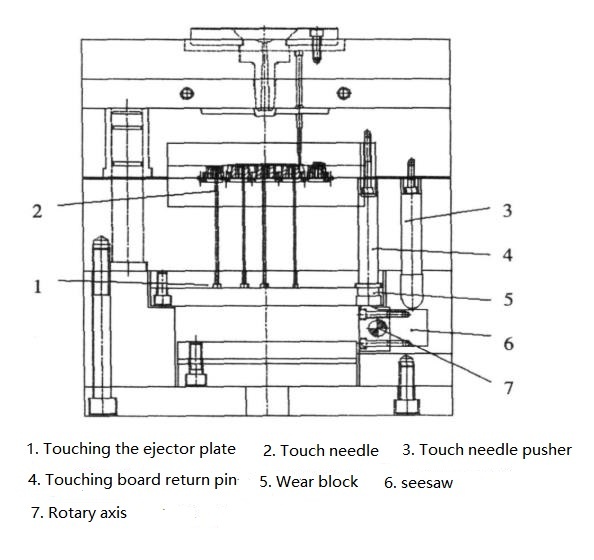
Application
The seesaw structure is mainly used in the design of keyboard molds with numbers and letters. Contains closed letters or numbers such as 0, 4, 6, 8, A, B, D, O, etc. Only the use of a seesaw structure allows the secondary material to flow smoothly into the enclosed area. Form a beautiful appearance.
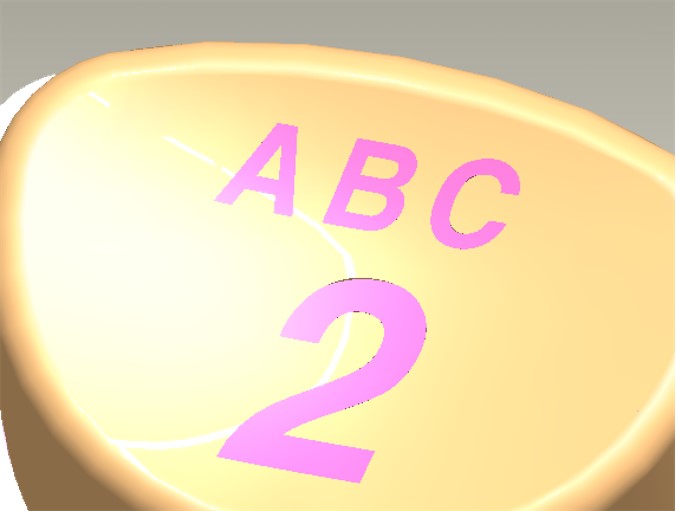
4. Index Plate Two-Shot Mold
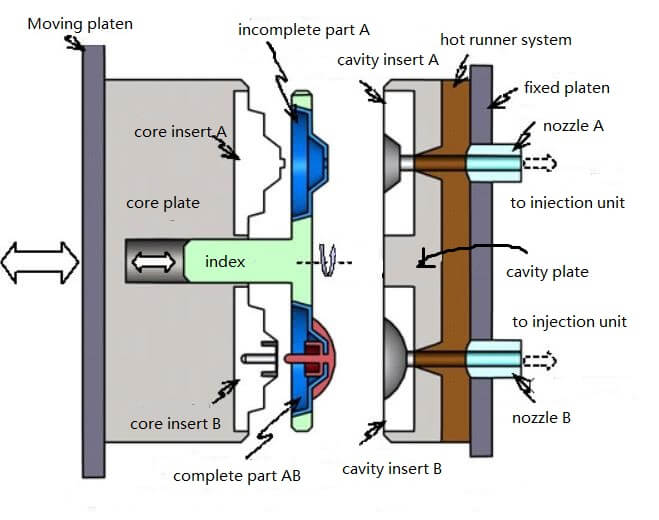
Index Plate Two-Shot Molding cycle

5. Cavity sliding structure
Working principle: After one injection, the mold is opened, and the male model cavity slides under the action of the motor. The mold is matched with the master mold at a certain distance, and the second injection molding is performed.
Then open the mold to eject the product. The male mold slides under the action of the motor. This structure is mainly used in two-color vertical machines.
33 suggestions for design of two shot mold
Conventional Design
No.1
First determine the direction of the parallel nozzle of the injection molding machine is the x-axis or y-axis. In this way, the product placement is determined.
No.2
The mold guide post guide sleeve must be matched.
No.3
The spacing of the products must be based on the spacing of the nozzles of the injection molding machine. The nozzle spacing of the two-color injection molding machine is somewhat adjustable, and some are not adjustable.
No.4
Note on the parting surface. The rear mold parting surface is the parting surface obtained after the combination of the two products. The front mold parting surface should be taken from a single product.
No.5
Carefully review the other reference data for the injection molding machine. For example, the maximum die thickness, the minimum die thickness, and the top hole spacing.
No.6
In designing the cavity of the second injection molding, in order to prevent the cavity from scratching the first molded product, a partial avoidance can be designed. However, it is necessary to carefully consider the strength of each seal position. For example: in injection molding. The plastic deforms under large injection pressure. Incurring a second injection may result in burrs.
No.7
When clamping the a, b plates, pay attention to whether the slider is reset before clamping. This will crush the product. To avoid this situation.
No.8
The water lines of the two chambers and core are as full as possible. And it is balanced and the same.
No.9
In 99% of cases, the hard plastic part of the product is first formed. The soft plastic part is molded a second time. Because the soft rubber is easy to deform.
No.10
Pay attention to whether the first molded product will be displaced by the impact of plastic during the second injection molding. This causes a change in the plastic wall.
Rotary die design
No.11
Two separate ejector systems, two top sticks.
No.12
The direction of water in and out of the water must be on the upper and lower sides. And every circulating water must go in and out on the same side. Do not enter water from the upper side and exit from the lower side. It should be noted that the size of the mold blank should not exceed the height of the sink of the injection molding machine. Otherwise, the water line cannot be connected.
No.13
It must be ensured that the side locks match the two front side locks after rotation. The front and rear molds match each other. Otherwise, when the rear mold is rotated by 180°, interference with the front mold causes the mold to fail to close.
No.14
The ejector plate can only be reset with a spring and cannot be forced to reset with a screw.
No.15
After the mold is designed, it is simulated to rotate 180°. The mold cannot interfere with the injection molding machine Gelin column.
No.16
The first injection molded product should be placed on the non-operating side. Because the product is rotated 180 degrees for the second injection after the first injection. Go to the operating side to remove the product. In order for the mold not to be reversed. We generally introduce a large C angle on the outside of the mold.
No.17
After rotating 180°, the front and rear molds must be matched. This check must be done during design.
No.18
When the ejector mechanism on the secondary injection molding machine cannot be used, a hydraulic ejector mechanism must be provided on the rotary table.
Tolerance reference
No.19
The front and rear flanges have a dimensional tolerance of minus 0.05 mm. The spacing tolerance between the two flanges is plus or minus 0.02mm. The gap between the top stick and the top stick hole is 0.1 mm on one side. The center-to-center tolerance of the front and rear mold bushings and the guide post is plus or minus 0.01. Tolerances are added to the four sides and depth of the mold frame. Otherwise, when the rear mold is rotated 180 degrees, burrs are generated due to high and low inconsistencies. The frame depth tolerance is minus 0.02 mm.
No.20
When processing the nozzle and the top stick hole, take the number based on the center of the pitch of the four guide post guide holes. Otherwise, there are too many deviations and it is easy to get stuck.
No.21
Pay attention to positioning before and after the mold. The slope of the touch surface is as large as possible. The best 0.1mm or more.
Thimble and shrinkage
No.22
Note that the product cannot be dropped when the mold is rotated. Automatic gate separation. There is no need to place a thimble for injection molding. Simply place the thimble on the core of the soft gel. Also pay attention to shrinking. If the soft plastic is completely entangled with hard plastic, just shrink the hard plastic. If the contour is connected, both materials should be considered to shrink.
No.23
Pay attention to the position of the thimble hole with a minimum interval of 210mm.Large molds must properly increase the number of KO holes.
Injection molding machine itself comes with a thimble is not long enough. Therefore, it is necessary to design a long thimble in our mold. The thimble is about 150 mm longer than the base of the mold base.
Gate selection
No.24
Be sure to carefully select the location of the gate. The first molding is best to choose a sub gate. This way the product and runner can be automatically detached. When it is not possible to use sub gate, consider a three-plate mold or hot runner mold. If the first injection is a point gate, the cavity should be designed with a wave. Avoid burrs remaining in the break of the gate at the time of one molding to penetrate the secondary material.
Material Selection
No.25
Usually the same plastic of different colors is used, or it can be two different plastic materials. At this time, it is necessary to consider the interface effect of the two materials, the difference in shrinkage rate, and the processing parameters.
No.26
In general, two-shot mold shrinkage depends on the material of the first molding. Because the primary material has already supported the contours of the plastic product, the secondary material does not shrink more. how to choose? There are many factors to consider, such as the fluidity of raw materials, the shape of plastic products, and so on.
No.27
ABS/PC, ABS/PC ABS, ABS/PMMA two-color injection molding, you need to first injection high temperature pc, pc abs or pmma. In the case of a transparent face shell mold, it is preferable to use a flip mold structure.
Large plastic parts and partially transparent
No.28
The gate location is reserved. Must agree in advance with the mold factory.
No.29
It is recommended to use a transparent 0.8mm or more for the material thickness. Non-transparent 0.7mm or more. The color of the non-transparent material is as shallow as possible.Considering such factors as shielding light.
No.30
The parting surface of the transparent part has the same width as the hole. The width is recommended to be 0.5mm. The surface is smoothed to avoid light transmission from the side. And try to reduce the holes.
No.31
Non-transparent parts have a limited thickness. The structure of the upper ribs and the like should be between 0.5 and 0.6 mm as much as possible to avoid shrinkage.
No.32
For large-area two-color injection molded parts, two key tests are drop and thermal shock. In both tests, the transparent and non-transparent parts were easily disengaged. Hot and cold shock -40degree-65degree, time 48 hours.
No.33
The structure on the two-color piece is as simple as possible. Complex structures can be made into fittings. Rib width of the non transparent member as far as 0.5-0.6mm. Avoid shrinking.
9 suggestions for two-shot molding
No.1
The hard plastic is molded for the first time, and the soft plastic is molded for the second time. Transparent for the first time, non-transparent for the second time. The plastic with high molding temperature is molded for the first time, and the plastic with low molding temperature is used for the second molding.
No.2
Before the official production, test the mold to produce a complete product.
No.3
Identify all possible defects in the process and eliminate them before the mold is manufactured.
No.4
Consider the shrinkage of the two materials.In general, shrinkage is determined by the material that is first formed.
No.5
A second injection can only be made after the first injection has been completely completed.
No.6
Consider the molded position, to prevent damage in the process.
No.7
Allow the edge of the first injection molded part to be too large. This ensures a higher pressure during the second injection.
No.8
Ensure that the parameters of the injection unit provide the required pressure, flow rate and cooling capacity.
No.9
Ensure that the structural strength of the first molded part can withstand the injection pressure of the second molding.
5 suggestions for maintenance of two shot mold
No.1
Check for loose or damaged fastening parts of the double shot mold. The solution is to find parts of the same specification for replacement.
No.2
After the mold has been used for a long time, the cutting edge must be cleaned and ground. After grinding, the surface of the cutting edge must be demagnetized, otherwise it will easily block the material.
No.3
Elastic parts such as springs of the two-shot mold are most susceptible to damage during use. Breakage and deformation usually occur.
No.8
The method adopted is to replace, and the specifications and model of the spring must be paid attention to during the replacement process.
No.4
Two-shotmold punch during use prone to breakage or bending. Damage to the punch and the sleeve is generally replaced with parts of the same specification. The parameters of the punch mainly include the working part size, the mounting part size, and the length size.
No.5
Check the pressure plate, top plate and other parts of the double shot mold. During maintenance, check the accessories of each part and whether there is any damage, and repair the damaged parts. Pneumatic ejector check for air leaks, and specific measures taken.
Conclusion
Two-shot molding increases the added value and productivity of the product. At the same time, plastics are becoming more and more colorful.
Correspondingly, the cost of two-shot molding is higher. Master the design points and avoid risks in advance. Avoid cost waste.
If you have any questions, please contact us directly. Get free technical support.
